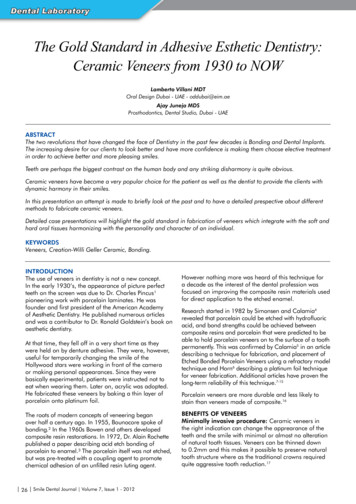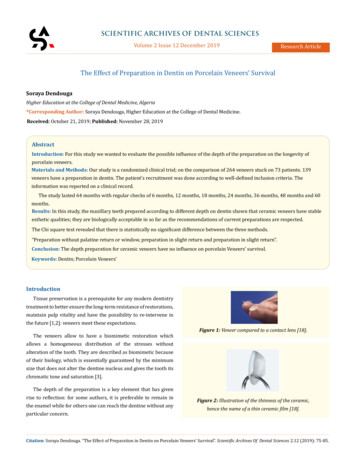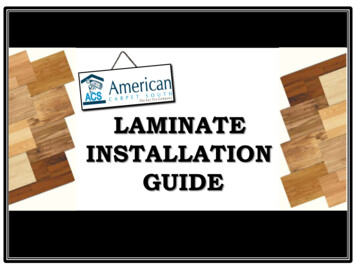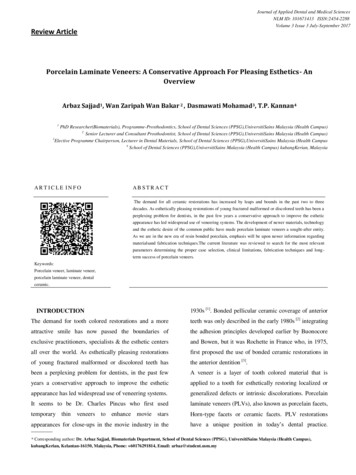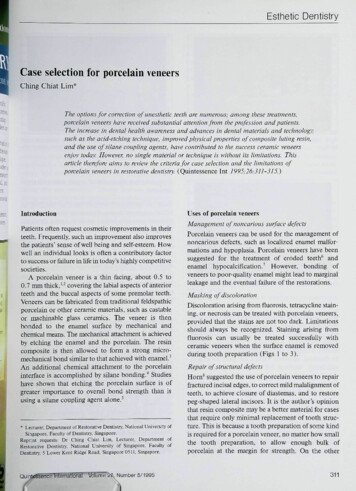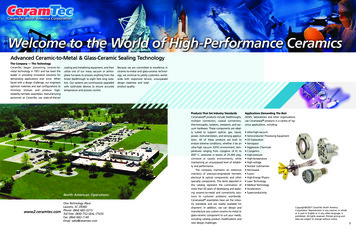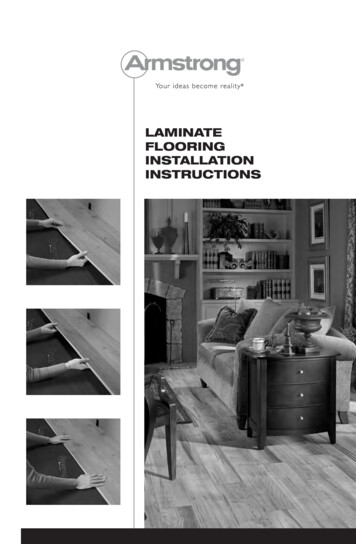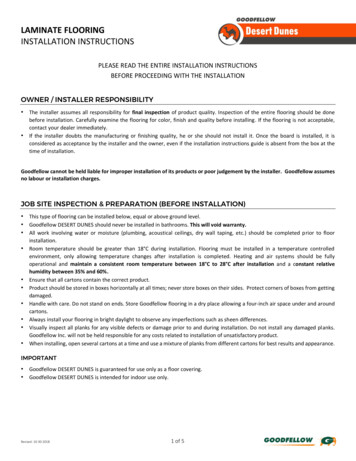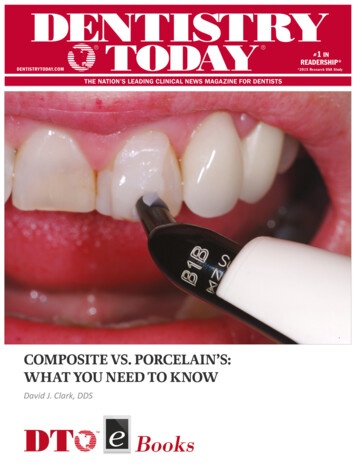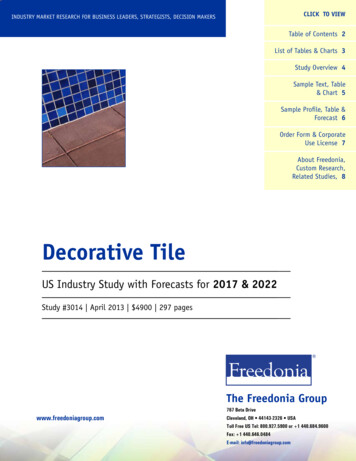
Transcription
Open Journal of Stomatology, 2014, 4, 268-279Published Online May 2014 in SciRes. /10.4236/ojst.2014.45038Ceramic Laminate Veneers: MaterialsAdvances and SelectionNasrin R. SadaqahDepartment of Prosthodontics, Faculty of Dentistry, Arab American University, Jenin, PalestineEmail: na sadaqa@yahoo.comReceived 2 April 2014; revised 5 May 2014; accepted 13 May 2014Copyright 2014 by author and Scientific Research Publishing Inc.This work is licensed under the Creative Commons Attribution International License (CC tractPorcelain laminate veneers have been a common treatment strategy in dental clinics. It is a conservative method for treatment of esthetic and functional problems in anterior region of oral cavity. Wide range of dental ceramics is now available on market for fabrication of laminate veneers.Clinician should have enough knowledge regarding the composition and properties of these materials in order to be able to choose the appropriate one according to clinical situations.KeywordsLaminate Veneers, Dental Ceramics, Ceramic Veneers1. IntroductionSince its introduction in 1938 by Charles Pincus [1], ceramic laminate veneer restorations have proven to bedurable and aesthetic restorative procedure for treatment of teeth in the front area of the mouth.Ceramic laminate veneers are more conservative than crowns [2], and maintain the biomechanics of an original tooth with a success rate of approximately 93% over 15 years of clinical use [3]. Because of that the indications of this procedure expanded to a point where its use is now a common practice in dental clinics, the presentbroad range of indications for ceramic laminate veneers includes [4]:1) Correction of alternations in tooth shape or position.2) Changes in morphology of teeth with microdontia or tooth transposition.3) Presence of diastemas and/or poor incisal embreasures.4) Repair of incisal fractures.5) Extensive anterior dental restorations.6) Enamel alterations (abrasion, attrition, abfraction).7) Change in tooth color.How to cite this paper: Sadaqah, N.R. (2014) Ceramic Laminate Veneers: Materials Advances and Selection. Open Journalof Stomatology, 4, 268-279. http://dx.doi.org/10.4236/ojst.2014.45038
N. R. Sadaqah8) Anterior guide rehabilitation.9) Repair of crown and bridge.However, when dealing with this great variety of clinical situations, not all ceramics behave as required. Oneof the most important factors for clinical success of ceramic laminate veneers is the proper selection of ceramicto be used.Therefore, it is the purpose of this review article to discuss the ceramics used to fabricate ceramic laminateveneers, in order to address some concerns about their composition and their manufacturing technique. In addition, the current review will cover the choice of ceramic materials for fabrication of ceramic laminate veneersaccording to clinical indications.2. MethodologyAn electronic search of publications was made using electronic databases Medline and Pubmed. Only Englishlanguage articles were included in this review.A combination of the following keywords was used: Laminate veneers, Ceramic veneers, Porcelain veneers,Dental ceramics. All articles from both electronic databases were collected and duplicates deleted. In general theselected articles met the following inclusion criteria: clinical trials, case reports, review or systematic reviewsand prospective studies, all written in English.3. Dental Ceramics Classification According to CompositionTo improve aesthetics in anterior teeth by mean of ceramic laminate veneers several types of ceramic materialsare used.A brief review is required of the classification of ceramic materials in order to define the best choice of eachaccording to clinical situation.There are three possible classifications of ceramics based on: sinterization temperature, composition andmanufacturing technique involved. This review focuses on the composition of the material since it offers all theneeded information to resolve the problem of current ceramic choice.Ceramics are classified according to their composition into:1) Glass based ceramics: Feldspathic porcelain, IPS Empress, IPS Empress II, and e-max Press.2) Alumina based ceramics: In-ceram Alumina, In-ceram Spinell, In-ceram Zirconia, Procera All Ceram.3) Zirconia Based Ceramics.4. Glass Based CeramicsThe feldspathic porcelain is composed of three main components: quartz, felspate and kaolin, with the basiccomponent being silica dioxide [4] [5].Feldspars are mainly comprised of silica dioxide (60% - 64%) and aluminum oxide (20% - 23%) and aremodified in different techniques to create glass that can be used in dental restorations [6] [7].Feldspathic porcelain has low mechanical properties with flexural strength from 60 to 70 MPa [6], due to thehigh glass contents in this material they are much more susceptible to fracture under mechanical stress. Therefore, ceramic laminate veneers fabricated from feldspathic porcelains gain their strength from good bond incombination with a stiffer substrate enamel [8]. With this material it is possible to have a veneer thickness ofless than 0.5 mm with or without preparation in enamel. The ideal conditions for the bond between thefeldspathic veneer and the substrate are the presence of 50% or more of enamel on the tooth, 50% or more of thebonded substrate being enamel; and 70% or more of the margin being in enamel [8].Traditionally feldspathic ceramic veneers are fabricated using layering technique which incorporates refractory dies used to support the condensed layers or ceramic slurry [9]. This technique gives the technician fullcontrol over the layers incorporated resulting in a naturally looking restoration. On the contrary, it requires investing time and effort in order to produce accurately fitting restorations. Duplicating the working model withbrittle refractory material and removal of refractory material after firing the veneers are sensitive procedures[10]. To overcome these problems in fabrication of feldspathic porcelain laminate veneers, machinable feldspathic ceramics are now used in chairside CAD/CAM (computer aided design/computer aided manufacturing)[11] [12]. The CAD/CAM prefabricated blocks initially present with good mechanical strength because they are269
N. R. Sadaqahmanufactured under precise controlled conditions which result in fine crystals and no pores [13] [14].Vita Mark II (Vita Zahnfabrik, Bad Sackingen, Germany), a machinable feldspathic porcelain introdced in1991 for the CEREC 1 system (Siemens AG, Bensheim, Germany) has improved strength and finer grain size (4µm) as compared to conventional feldspathic porcelain [15] [16]. It is composed of SiO2 (60% - 64%) and Al2O3(20% - 23%) and can be etched using hydrofluoric acid to create micromechanical retention for resin cement[16]-[18]. Although this product is monochromatic, it is available in several shades including the classical lineVita shades, Vitapan 3D-Master shades, VITABLOCS Esthetic Line, and bleached shade, and can be additionally characterized [16] [19]-[22].To overcome esthetic disadvantages of a monochromatic restoration a multicolored ceramic block (Vita Triluxe Bloc, VITA Zahnfabrik) was designed to create 3-dimensional layered structure [23]. The inner third has adark opaque base layer, while the moderate third has a neutral zone and the outer third is translucent. CERECsoftware allows the operator to have some visual control over the alignment of the restoration within multilayered block [23] [24].Feldspathic porcelain gives great aesthetic value and demonstrates high translucency just like natural dentition[25].Using feldspathic porcelain to fabricate ceramic laminate veneer will provide the following advantages: 1) reproducibility of tooth color with a thin layer of material, 2) low laboratory cost compared to other ceramic systems, 3) excellent mechanical retentive characteristics after etching with hydrofluoric acid and the presence ofadequate amount of enamel, 4) excellent bonding characteristics with the use of appropriate silane bondingagents [26].When compared with feldspathic porcelain other glass ceramics have improved mechanical fracture resistance,improved thermal shock resistance, and resistance to corrosion. Increased mechanical properties depend on theinteraction of the crystals and glassy matrix, as well as on the size and amount of crystals. Finer crystals generally produce stronger materials. Glass ceramics may be opaque or translucent depending on the chemical composition and amount of crystals embedded in matrix [6] [27].Increased strength of glassy ceramics is achieved by adding appropriate fillers that uniformly dispersedthroughout the glass, such as leucite and lithium disilicate [28].Leucite and lithium disilicate reinforced ceramics are indicated to fabricate veneers due to their optical properties and because they are acid sensitive [29]. These materials can be translucent even with high crystallinecontent, this is due to the relatively low refractive index of crystals [28].The flexure strength of glass based ceramics is improved and depends on the shape and volume of the crystals.The glass matrix is infiltrated by micron size crystals of leucite and lithium disilicate, creating a highly filledglass matrix [7]. The resistance to flexion is 160 - 300 MPa for leucite reinforced ceramics, and 320 - 450 MPafor lithium dioxide reinforced ceramics [4].Glass ceramics are fabricated through lost wax and heat pressed techniques, or using machinable technique[30] [31].When the veneer is fabricated by heat pressing method, the restoration is first waxed-up and invested, the ingot which is made of sintered ceramic is softened and pressed into a mold under pressure. The shades of the ingot provide the basic shade which can be modified by staining [32].The leucite crystals in leucite reinforced glass ceramics (IPS Empress-Ivoclar Vivadent) compose 50% - 55%of the material, this material has a refractive index that is very close to feldspathic ceramics, in addition to thatleucite reinforced ceramics have a faster rate of etching than base glass, this selective etching is the factor thatprovide tiny features for resin cements to enter creating strong micromechanical bond [31].IPS ProCAD (Ivoclar Vivadent) is a leucite reinforced ceramic similar to IPS Empress although it has a finerparticle size [16]. It was introduced in 1998 to be used with the CEREC inLab system (Sirona Dental Systems,Bensheim, Germany) and is available in different shades including bleached shade and an esthetic block line [16][33]-[35].Lithium disilicate reinforced ceramics (IPS Empress II—Ivoclar Vivadent) are true glass ceramics with a lithium disilicate crystal content of 70% [6] [31].IPS e-max press (Ivoclar Vivadent) was introduced in 2005 as an improved press-ceramic material comparedto IPS Empress ceramics. It is a lithium disilicate pressed glass ceramic but it has better physical properties andtranslucency [36]. The crystalline volume and reactive index of IPS e-max press ceramics differ from these ofIPS Empress and IPS Empress II ceramics with IPS e-max being more translucent [37].270
N. R. Sadaqah5. Alumina Based CeramicsAlumina based ceramics include: In-ceram porcelains and Propcera All Ceram.5.1. In-Ceram PorcelainsIn ceram is an infused ceramic. It consists of a core of reinforced material which is built upon a refractory die.During firing the die shrinks so it can be withdrawn from the core, this process is called slip casting technique.At this stage the core is weak, porous structure. Strength is conferred by painting a slurry of lanthanum containing glass onto the outside of the core and refiring it. During refiring the molten glass is drawn into the porousstructure thus eliminating voids and creating a glass-ceramic composite [38].Due to differences in the coefficient of thermal expansion of the alumina and glass compression stresses werealso improved [39].According to the composition In-ceram porcelain is classified into: In-ceram alumina, In-ceram spinell, andIn-ceram zirconia.5.2. In-Ceram AluminaIn-ceram alumina introduced in 1989 [40], and it is composed of 85% aluminm oxide particles measuring 2 - 5µm in diameter. This high alumina content affords a resistance to flexion of 400 - 600 MPa [4].In-ceram alumina ceramics have a higher strength and fracture toughness than leucite reinforced glass ceramics and conventional feldspathic porcelain [41]-[43], while they have a lower translucency than glass based ceramics [44].Alumina blanks (VITABLOCS In-Ceram Alumina, VITA Zahnfabriks) are also available for milling in combination with CEREC Sirona Dental systems [45] [46].5.3. In-Ceram SpinellIn-ceram spinell was introduced in 1994 as an alternative to the opaque core of In-ceram alumina. It contains amixture of magnesia and alumina (MgAl2O4) in the framework to increase translucency [37] [44]. This translucency is attributable both to the crystalline origin of the spindell which confers isotropic optic properties and tothe low refraction index of the crystals [4]. However, its flexural strength is lower than that of In-ceram alumina[47].It was found by Heffarenan et al. [44] that In-ceram spinell has the highest amount of relative translucencywhen compared with IPS Empress, IPS Empress II and In-ceram alumina.This material can be machined with CEREC in Lab system (Sirona Dental Systems) followed by veneeringwith feldspathic porcelain [22] [45].5.4. In-Ceram ZirconiaIt is a modification of the original In-ceram alumina, it is composed of 67% aluminum oxide and 33% partiallystabilized zirconium oxide [4].A zirconia modified alumina ceramic (In-ceram zirconia) has higher fracture toughness and flexural strengththan In-ceram alumina, with flexural strength of 600 - 800 MPa [48]. In-ceram zirconia has an opaque core thatlacks translucency, its opacity is comparable to metal alloy [44] [49] [50].Prefabricated partially sintered blanks of In-ceram zirconia are also available so that the restoration can be fabricated by copy milling and then veneered with feldspathic porcelain [5] [51].5.5. Porcera All-CeramProcera was developed by Andersson and Oden in 1993. This material is fabricated from copings that contain99.9% high purity aluminum oxide, these copings are coated with conventional aluminum ceramic [52] [53].Procera has the highest strength when compared with glass and In-ceram ceramics with a fracture resistanceof 680 MPa [4], and it’s strength is lower only than zirconia based ceramics [53] [54]. It was stated by Heffernan et al. [44] that Procera All-ceram has a higher level of translucency than In-ceram alumina and zirconia.Procera all-ceram restorations are fabricated using dry pressing technique [53] [55], the working die is271
N. R. Sadaqahscanned to define the 3-dimensional shape of the preparation [55]. The data is sent electronically to manufacturing facility where a 20% magnified model is copy-milled and used for dry pressing technique [53] [55]. A highpurity aluminum oxide powder is mechanically compacted on the enlarged die and sintered at 1550 C eliminating porosity and returning the core to the dimensions of working die [46] [55] [56].Different surface treatments have been evaluated to demonstrate the bond strength of composite resin cementsto alumina-based ceramics. It was found that these ceramics are not sensitive to hydrofluoric acid etching, so aneffective method to roughen the alumina based ceramics is pretreatment by airborne particle abrasion [57].6. Zirconia Based CeramicsZirconia based ceramic is polycrystalline material that contain no glass, all the atoms are packed into regularcrystalline arrays through which it is much more difficult to drive a crack than it is in the less dense and irregularnetwork found in glasses. So polycrystalline ceramics are much tougher and stronger than glass-based ceramics[58].Prosthesis made from polycrystalline ceramics was not practical before the availability of computer aidedmanufacturing [58].Zirconia based ceramics has three forms, at its melting point of 2680 C, the cubic structure exists and transforms into the tetragonal phase below 2370 C [59]-[61], transformation from tetragonal to monoclinic phaseoccurs below 1170 C and is accompanied by a 3% - 5% volume expansion which causes high internal stresses[60] [61].To control the volume expansion and to stabilize the zirconia in the tetragonal phase at room temperature Yttriumoxide (Y2O3 3% mol) is added [62]. This partially stabilized zirconia has high initial flexural strength andfracture toughness [62]. Under tensile forces the tetragonal phase transforms to monoclinic phase with an associated 3% - 5% localized expansion [63], this volume increase creates compressive strength at crack tip thatcounteract the external tensile stresses. This phenomenon is known as transformation toughening and retardscrack propagation. The toughening mechanism will not prevent the progression of a crack, it just makes it harderfor the crack to propagate [59] [62]-[64].Yttrium oxide partially stabilized zirconia (Y-TZP) has attractive mechanical properties as chemical and dimensional stability, high mechanical strength and fracture toughness [65]. It has a fracture modulus of 900 MPaand hardness of 1200 vickers units [4]. The cores of zirconia based ceramics have a radiopacity comparable tometal [64].Using computer aided design/computer aided manufacturing (CAD/CAM) technology Y-TZP can be manufactured in two methods. In the first method the restoration can be milled from a homogeneous ceramic softgreen body blank of zirconia [66]. The framework has a linear shrinkage of 20% - 25% during sintering, so it ismilled in enlarged framework [67] [68]. Using softer presintered blanks will shorten the milling time and reducethe wear on the milling tools [67]. In the second method the restoration can be fabricated using (CAD/CAM)from fully sintered prefabricated blank into the final dimensions [66] [67], but this method may compromise themicrostructure and strength of material [69] [70].A system that mills the zirconia core in the softer “green” state and then sinters it, is superior to one that millsthe core in the sintered state. This is because the later requires a robust milling machine and high temperaturemilling that will result in near surface damage and defect formation which will significantly shorten the anticipated life span of the restoration [71]. Milling in the green state followed by sintering allows lower temperaturemilling, and the sintering heals any milling induced defects [72].7. Choice of Ceramic Material to Fabricate Porcelain Laminate Veneers Accordingto Clinical SituationTwo important factors will affect the choice of ceramic for fabrication of ceramic laminate veneers: the amountof functional loading to which the ceramic laminate veneer is subjected, and the needed change in shade by fabrication of ceramic laminate veneer.8. Functional Loading Effect on Material Choice of Ceramic Laminate VeneerWhen the amount of functional loads is extensive, the use of material with great resistance to fracture is needed[4].272
N. R. SadaqahGenerally higher tensile and shear stress occur when there are large areas of unsupported porcelain (as in cases of diastema closure and teeth with chipping or fracture), deep overbites, overlaps of teeth, when bonding veneers to more flexible substrates such as dentin and composite, when bruxism is present and when the restorations are placed more distally [73]. In these higher risk clinical situations high strength ceramics as aluminabased ceramics, zirconia based ceramics should be considered [4].9. Shade Effect on Material Choice for Ceramic Laminate VeneersIn porcelain laminate veneers the supporting tooth structure or aesthetic restorative foundation material is a primary source of the resulting color. This color is influenced by the thickness and translucency of the final veneerrestoration, as evidenced by the amount of reflection and scattering of light [44]. The amount of light that is absorbed, reflected and transmitted depends on the chemical nature and size of the particles within the core material, compared to the incident light wavelength [74].Translucency which is a natural phenomenon varies among ceramics and has been shown to be lower in ceramics than natural tooth enamel [75]. As such, clinicians face a challenge in selecting the shade of the ceramicveneer and reproducing optical properties similar to those of the adjacent natural teeth with high translucency,especially when the prepared teeth are severely discolored [76].If a ceramic restoration is placed on dark underlying tooth structure, the color beneath the ceramic might result in discoloration and shadowing of restoration [77].As translucency has increased with thinner ceramics, the color match in porcelain laminate veneers will bemore complicated. To eliminate undesirable effects, factors such as thickness of ceramics, ceramic type, ceramicshade and cement color should be considered [77]-[84].For correct ceramic choice in relation to color consideration the patients can be divided into two main types:type I patients: these are subjects programmed to receive esthetic changes where teeth present no color alternations. The only objective in these cases is to apply porcelain laminate veneers for shape modifications, type IIpatients: these patients are programmed to receive esthetic changes and the teeth present color alternations.Therefore in addition to shape modifications the selected ceramic material must be able to hide the underlyingteeth color.9.1. Type I PatientsSince the objective for using ceramic laminate veneers in these patients is to place a new more pleasing externalsurface on the tooth without changing the tooth color [85] [86], the use of conventional feldspathic ceramics inview of their excellent optic characteristics will afford optimum esthetic results [4].Generally, feldspathic porcelain materials are indicated for ceramic laminate veneers when the restorationreplaces enamel with minimal if any preparation into dentin [87].The indications for a non preparation or minimally invasive laminate veneer including teeth that have: displeasing shapes or contours and/or lack of size and/or volume, requiring morphologic modifications; diastemaclosure, anterior tooth alignment, restoring localized enamel malformations, flourosis with enamel mottling, andmisshapen teeth [85] [88] [89].The severity and extension of any of these factors must be evaluated because they will determine the treatment goals which have as much to do with restoring proper function as they do with aesthetics. The use of moreaggressive preparation may be necessary to achieve predictable functional results [90]. An example exception tothe above presented indications is the case in which the interincisal diastema is over 2 mm. In this case it mustbe taken into account that as the porcelain extends beyond the adhesion zone, it loses the protective increase inelastic modulus afforded by the adhesion and composite resin cement. In this case it is recommended to use highresistance glass ceramics since they have good esthetic qualities combined with adequate resistance to fracture[91].Due to low flexural strength of feldspathic porcelain the veneers fabricated from this ceramic are reinforcedby a good bond with a stiffer tooth substructure (enamel) [8], so flexural risk of feldspathic ceramic laminateveneers tend to be higher when bonding to a higher extension of dentin because dentin has more flexibility thanenamel. If bonding in enamel the flexural risk is low to moderate [90]. Because the enamel thickness of naturaltooth varies from 0.4 mm on the facial aspect in the cervical one third to 0.8 to 1.0 mm on the facial aspect in theincisal one third, the enamel replacement restorations (feldspathic ceramic laminate veneers) typically are 0.3 to273
N. R. Sadaqah0.5 mm thick and require minimal preparation [89].Feldspathic porcelain provides great esthetic value and demonstrates high translucency, just like natural dentition. By using a layering and firing process ceramists developed veneers that could be made as optically close tonatural teeth as possible [25].The glass ceramics can be used in clinical situations where flexural risk factors are included. With this material the thickness must be more than 0.8mm except at marginal areas they can be gradually thin to a margin ofapproximately 0.3 mm [8].Therefore in situations in which there is more than 0.5 mm of working space glass ceramics should be considered instead of feldspathic ceramics due to their increased strength and toughness, as well as the presence ofsufficient room to achieve the desired aesthetics. These materials are efficient in bonding to tooth structure evenif less than 50% of enamel is present, however at the margin at least 30% of the enamel must be present [8].9.2. Type II PatientsIn these patients the teeth show moderate to severe alternation in dental color that must be masked by restoration.In these situations both the porcelain and cement must present various degrees of opacity in order to hide thecolor alternations and this in turn implies problems to secure the desired optic effects in terms of translucencyand reflectance and consequently esthetic outcome [4].Other factor to be taken into account in these cases is dental preparation, which will be more aggressive (0.8 1.0 mm) and to the finish line which must be slightly subgingival [4].The materials indicated for these cases are ceramics offering the possibility of selecting the opacity of thebase material, regardless of the degree of resistance [4].Ceramics can vary from being translucent to very opaque. In general the glasser the microstructure (noncrystalline), the more translucent the ceramic will appear, the more crystalline, the more opaque. Other factors affecting opacity include particle size, particle density, refractive index and porosity [6].A material composed of small particles (0.1 µm diameter) is less opaque, whereas large particles (approximately 101 µm diameter) cause surface reflection as the light strikes, refraction as light passes through and absorption [92] [93].Different crystalline composition of the material determines the optical properties rather than constructiontechniques (firing, pressing, machining, etc ). When using translucent ceramic for fabrication of ceramic laminate veneers it has been shown that with the increase in ceramic veneer thickness light transmission was significantly reduced [94]. A color change in the foundation supporting 2 mm translucent ceramic veneer will notproduce clinically detectable color difference, when the ceramic thickness was 1.0 mm substrate color differences were distinguishable with human eye [95] [96].To produce the necessary thickness for the more translucent traditional feldspathic porcelain to mask staining,reduction through the dentin layer may be necessary which will compromise bonding [97]. Furthermore increasing the thickness of traditional feldspathic porcelain veneering may impede photo polymerization of lutingcement [98].Since it was shown that 2mm thick glass based ceramic veneers were not affected by the substrate color butwhen ceramic thickness was 1 to 1.5 mm, visually appreciable differences in color were observed [99], otherless translucent core materials should be considered for patients with discolored teeth.The opaque nature of zirconia laminate veneers offers an advantage over traditional feldspathic and glassbased ceramics in masking undesirable tooth colors. The color difference between zirconia core and adjacentnatural tooth should be reduced through layering technique for the veneering porcelain [100].Another ceramic that is effective in color masking is the alumina base ceramics. It was demonstrated thatalumina based ceramic veneer within 0.7 mm total thickness will be sufficient to mask underlying tooth color[101].Heat pressed alumina laminate veneers with 0.25 mm thickness (Procera AllCeram; Nobel Biocare, YorbaLinda, Calif) are able to mask discolored teeth [86].10. ConclusionsCeramic laminate veneers can be fabricated using glass based ceramics, aluminum oxide or zirconium oxide ce-274
N. R. Sadaqahramics.Successful ceramic laminate veneers depend upon clinician ability to select the appropriate material to matchintraoral conditions and esthetic demands.Conflict of InterestNo conflict of interest for author.References[1]Pincus, C.R. (1938) Building Mouth Personality. Journal of the California Dental Association, 14, 125-129.[2]Radz, G. (2011) Minimum Thickness Anterior Porcelain Restorations. Dental Clinics of North America, 55, 06[3]Friedman, M.J. (1998) A 15-Year Review of Porcelain Veneer Failure—A Clinician’s Observations. Compendium ofContinuing Education in Dentistry, 19, 625-628.[4]Fons-Font, A., Solá-Ruíz, M.F., Granell-Ruíz, M., Labaig-Rueda, C. and Martínez-González, A. (2006) Choice of Ceramic for Use in Treatments with Porcelain Laminate Veneers. Medicina Oral, Patología Oral y Cirugía Bucal, 11,E297-E302.[5]Tinschert, J., Natt, G., Mautsch, W., Augthum, M. and Spiekermann, H. (2001) Fracture Resistance of Lithium Disilicate, Alumina and Zirconia Based Three-Unit Fixed Partial Dentures: A Laboratory Study. The International Journalof Prosthodontics, 14, 231-238.[6]Giordano, R. and McLaren, E.A. (2010) Ceramics Overview: Classification by Microstructure and Processing Methods.Compendium of Continuing Education in Dentistry, 31, 682-684.[7]Conrad, H.J., Seong, W.L. and Pesun, I.J. (2007) Current Ceramic Materials and Systems with Clinical Recommendations: A Systematic Review. The Journal of Prosthetic Dentistry, 98, 389-404.http://dx.doi.org/10.1016/S0022-3
A combination of the following keywords was used: Laminate veneers, Ceramic veneers, Porcelain veneers, Dental ceramics. All articles from both electronic databases were collected and duplicates deleted. In general the selected articles met the following inclusion criteria: clinical trials, case reports, review or systematic reviews
